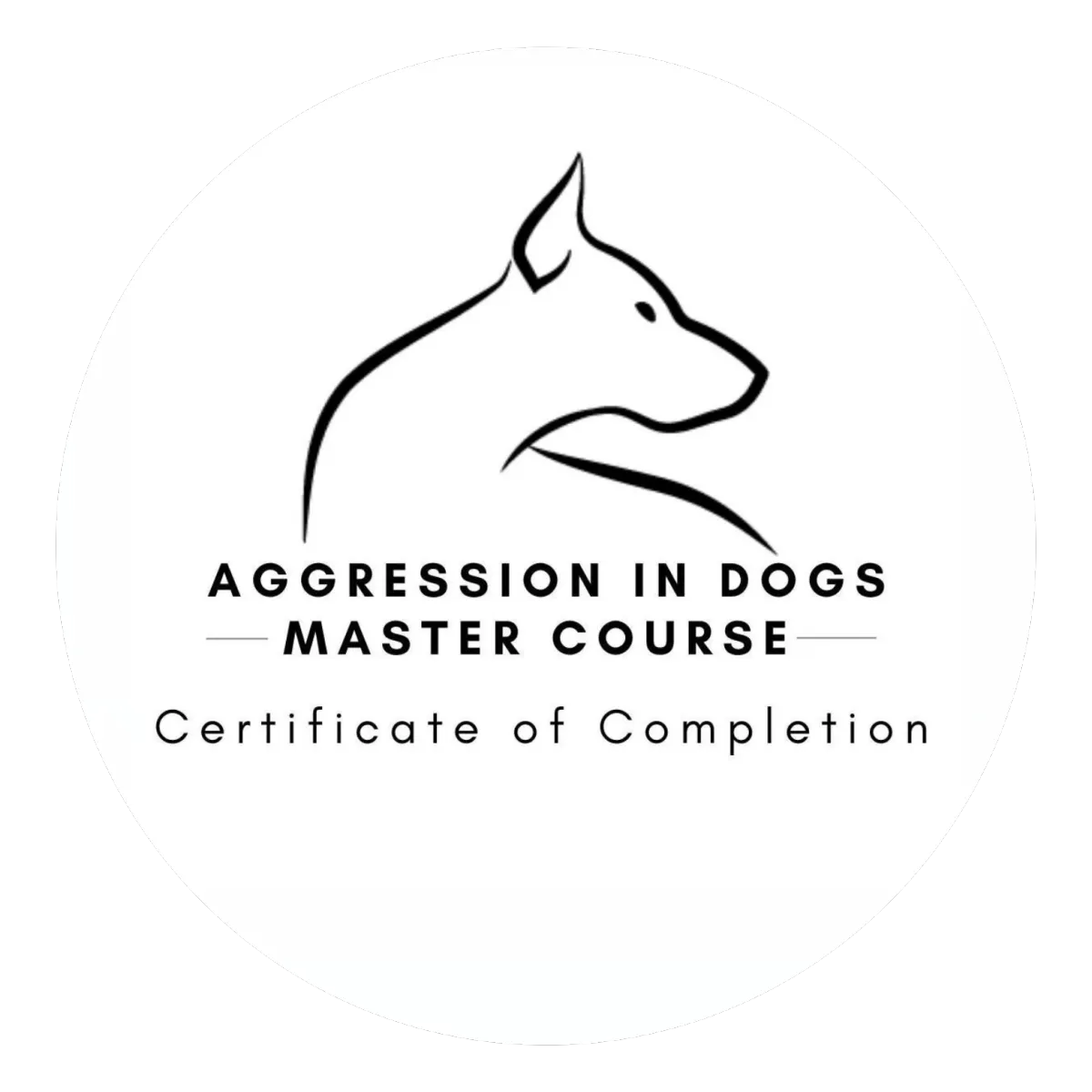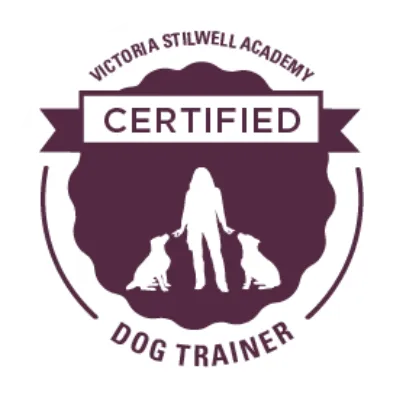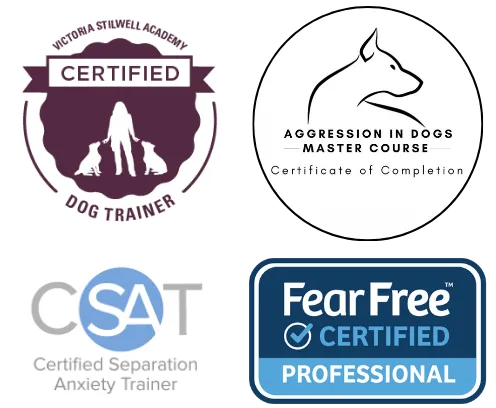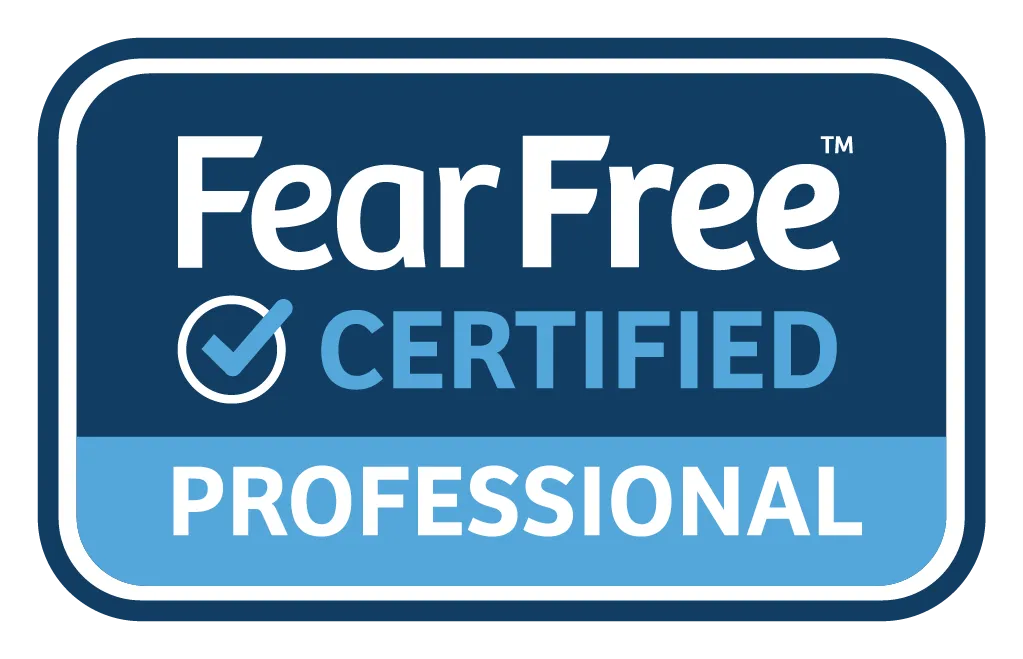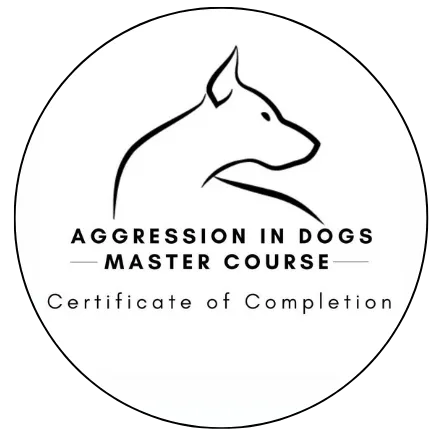Leashes
My Top Picks
Having a variety of leashes on hand offers unique advantages. For instance, a dual-attachment leash is ideal for leash training, a 6-foot leash provides freedom during sniffy walks, and a long line is helpful for practicing recall. With different leashes available, you and your dog have tailored training tools to choose from.


Dual-Attachment Leash
3.5' to 5' Length
Adjustable handle
Great for training leash manners
Designed for dual-clip & single-clip use
Designed for use with Positively No-Pull Harness

6-Foot Leash
6' Foot Length
Designed for single-clip use
Allows controlled exploration
Various color options
Ideal for advancing loose-leash walking

Long Lines
10' / 16' / 30' / 50' / 100' length
Allows free exploration
Enhances recall training
Ideal for practicing off-leash manners
Useful in BAT training
Check out the harnesses that you can use these with!
Leash Types
Fixed Length
Safest


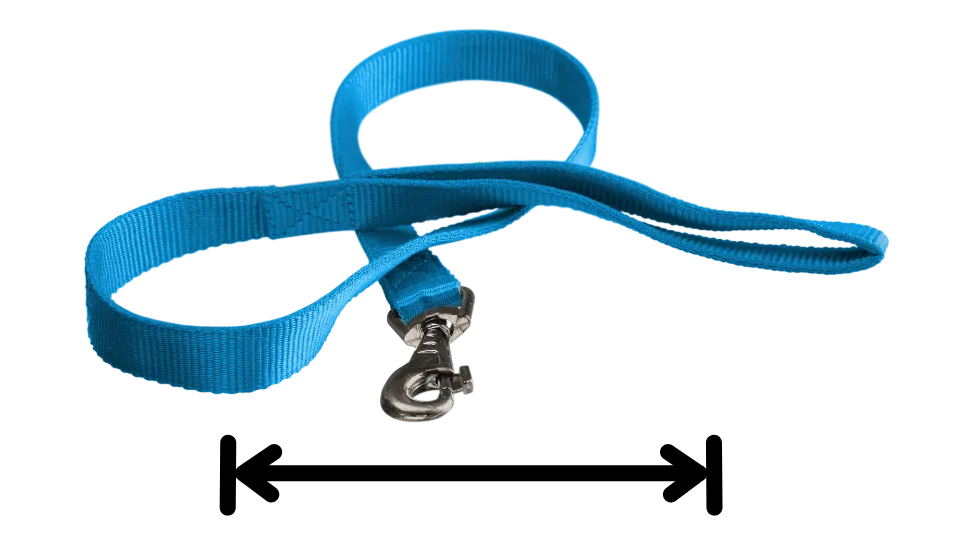
A leash of non-adjustable length.
Comes in lengths ranging 2 ft to 100 ft.
Includes:
Dual-Clip leashes
4' leash
6' leash
Long Lines
Any leash with non-adjustable length
Dual Clip
Safest



A leash with 2 clips attachments for connecting to two areas on a dog's harness.
Versatile
Useful for training leash manners
Best for use with dual-clip harnesses
Works well for dogs that pull
Waist Leash
Use with caution


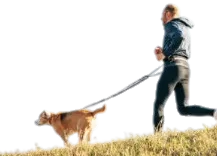
A hands-free dog leash worn around the human's waist.
Hands-free
Reduces human shoulder strain
Useful if dog needs supervision
Limited precision / control
Training needed
Not for all walking situations
May affect your balance if dog pulls
NOT for dogs with reactivity
Y-Leash
Use with caution


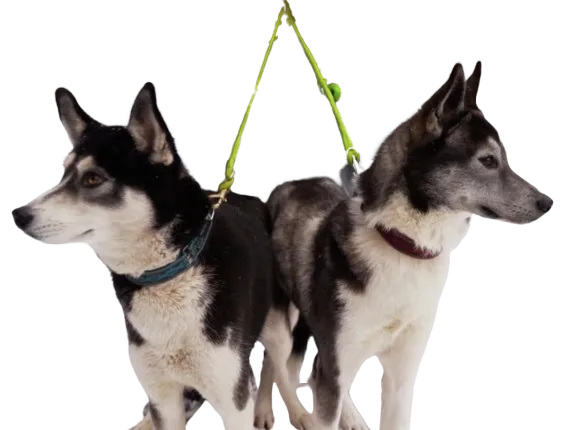
AKA "Leash Coupler" or "Double Leash"
A leash attachment branching into two sections that lets you walk two dogs at once using one leash.
Allows you to walk 2 dogs simultaneously
Restricted movement for both dogs
Strength disparity between dogs
Dogs may have different walking behaviors & needs
Proximity, tension on leash, and other factors can lead to frustration, potentially resulting in redirected aggression.
NOT for dogs with reactivity
Do not use for dogs who pull
Retractable Leash
Not recommended



A leash with a thin cord that extends and retracts from a handle, allowing taut, adjustable lengths.
Thin cord can cause serious injuries if tangled or snapped
Often encourages pulling behavior
Lack of control can lead to dangerous situations
Tripping hazards
Due to safety reasons, I don't recommend this leash at all, even for dogs who are leash trained. Safety first!
Slip Leash
not recommended



A leash that forms a loop, which tightens around the dog's neck when pulled.
The appropriate use of slip collars is limited to unusual situations like veterinary and shelter contexts. NOT for training/ home use!
Can cause serious injury to dog (especially to neck)
Potential for choking or strangulation
Do not use with dogs who pull
Do not use with dogs who have respiratory issues
Is your dog pulling?
Schedule your discovery call today!
Material Types

Chain / Metal
PROS:
Highly durable & can withstand heavy use
Easy to clean
Useful in water
Useful for dogs who like to chew
CONS:
Heavier weight (can be too heavy for smaller dogs)
Limited variety of lengths
Metal can damage dog's teeth (if they chew)
Other potential for injury; proper handling necessary
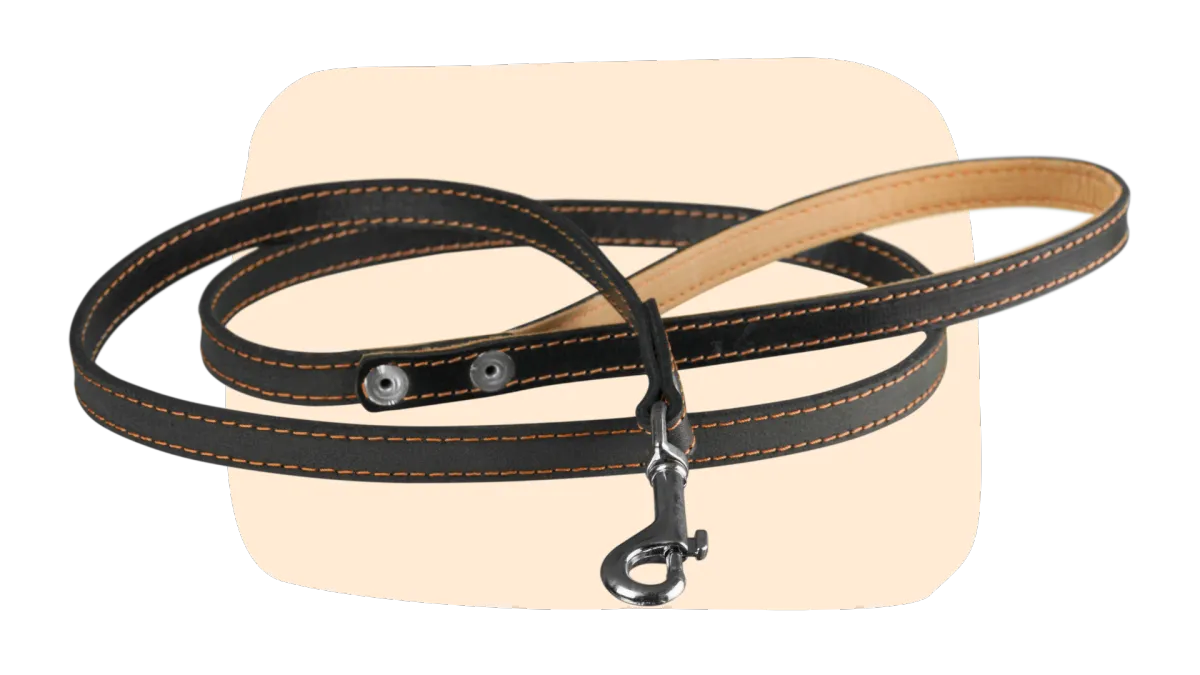
Leather
PROS:
Known for their strength
Flexible material
Can be quite durable
Elegant appearance
CONS:
Can be more expensive
Can be heavier than other materials
May require regular maintenance to ensure longevity
Can harden when wet
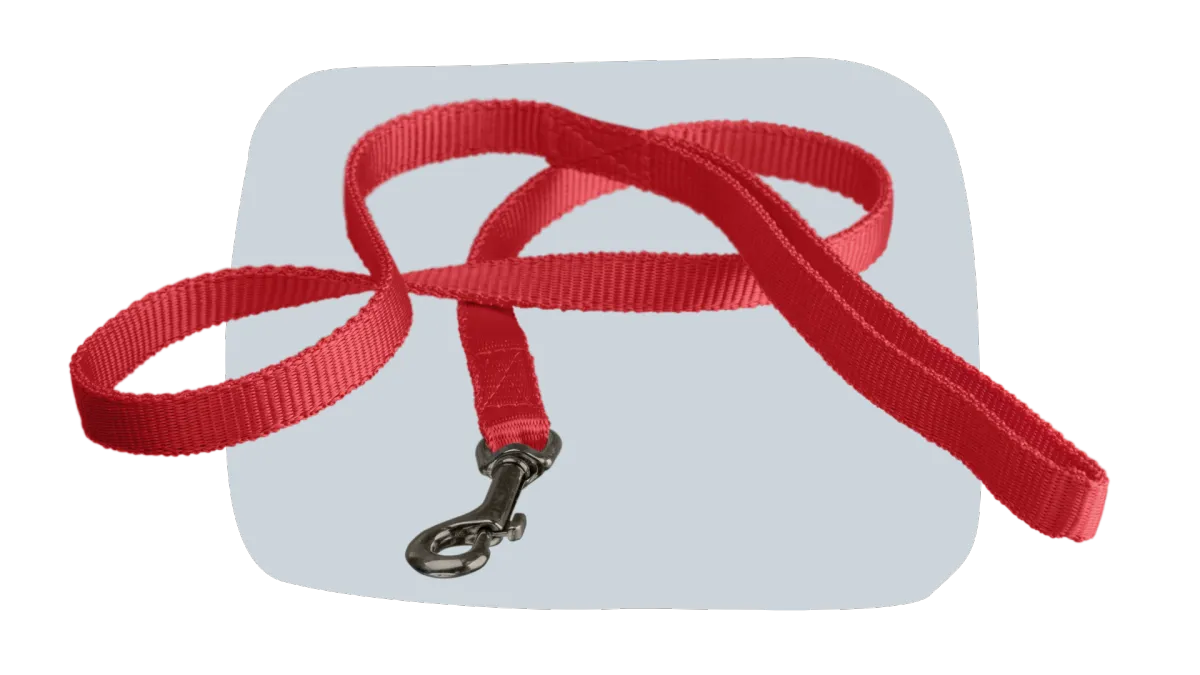
Nylon
PROS:
Durable, washable, & weather-resistant
Affordable
Lightweight & comfortable to hold
Comes in various lengths and widths to accommodate dogs of different sizes
CONS:
May be too lightweight for larger dogs
Can be uncomfortable for some handlers to hold
Material may fray, especially if dog chews on leash

Cotton
PROS:
Soft & comfortable
Lightweight
Washable
Offers better grip, reducing chances of leash slipping out of hands
CONS:
Less durable compared to nylon or leather
Can wear out more quickly
Prone to fraying
Has tendency to absorb moisture, so leash can become heavier when wet
Frequently Asked Questions
What type of leash is best for teaching my dog leash manners?
This depends on your dog and your walking goals. As a general recommendation, dual-clip leashes allow for flexibility. They can be used for training when both clips are attached to a harness, and also function as a fixed-length leash for regular walks or other activities.

How do I know which leash length is suitable for my dog's needs?
The suitable leash length for your dog depends on various factors, including their size, behavior, and the purpose of your walks.
A 3 to 4-foot leash provides close control and is ideal for training sessions or walking in crowded areas where you need to keep your dog close by your side.
A 6-foot leash offers a balance between freedom and management. It provides enough slack for your dog to explore and sniff their surroundings while still keeping them within reach. This length is suitable for leisurely walks in parks or neighborhoods, allowing your dog some autonomy.
Long lines, typically ranging from 10 to 30 feet or longer, are useful for training purposes, recall exercises, or activities like tracking or agility. They give your dog more freedom to roam and explore while still under your supervision. Long lines are beneficial for practicing off-leash behaviors in controlled environments or for allowing your dog to run and play safely while remaining connected to you.
When choosing a leash length, consider your dog's temperament, training level, and the environments you frequent. It's also essential to ensure that the leash material is sturdy and comfortable for both you and your dog. Experiment with different lengths to find the one that best suits your and your dog's needs!
Are there specific leash types that work better for certain breeds or sizes of dogs?
Different breeds and sizes of dogs have unique leash needs. Larger breeds may require sturdier fixed-length leashes to manage their strength, while smaller dogs may prefer lighter options. Dual-clip leashes are versatile options suitable for dogs of all sizes and breeds.
When purchasing a leash, consider the thickness. Thicker leashes (around 1") are better for larger breeds, offering strength and durability. Thinner leashes (1/2" or less) are usually lighter and more comfortable for smaller dogs.

What are the benefits of using a fixed-length or dual-clip leash over other types?
I like to say that the leash is a communication tool, not a control tool.
Fixed-length and dual-clip leashes provide consistent management, allowing you to maintain clear communication and reinforce desired behaviors effectively. These leashes promote safer and more focused walks, enhancing the training experience for both you and your dog.
Is it safe to use a retractable leash for training or walking my dog?
Retractable leashes can pose serious safety risks and I do not recommend them, even for dogs who have leash manners. The extended length of retractable leashes can make it difficult to maintain control in many situations, increasing the risk of accidents or injuries. Additionally, the thin cord or tape used in retractable leashes can cause burns, cuts, or entanglement on both you and your dog. Opting for a fixed-length or dual-clip leash provides better control and safety during training and walks. Safety first!
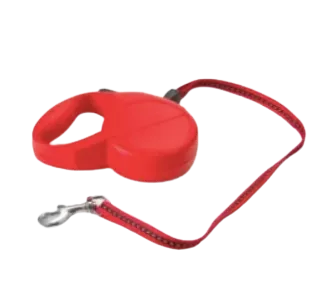
What should I consider when choosing a leash for walking or jogging with my dog?
When selecting a leash for walking or jogging with your dog, consider factors such as comfort, control, and safety. Also consider your dog's pulling habits and leash manners.
Although it's not hands-free, a 6 to 8 foot fixed-length leash allows some space and freedom of movement for both you and your dog and is a great option.
Waist leashes can also be convenient for jogging as they keep your hands free, but it's essential to ensure a proper fit. If you have a dog that is very strong or pulls excessively on the leash, train your dog to fluency with leash manners before using the waist leash. This is the best way to prevent accidents or injuries. Bear in mind, there is always a risk of being knocked off your feet when using a waist leash, especially if you have a dog that moves faster than you, has high prey drive, or is very strong.
Additionally, choose a leash made of durable materials that can withstand the rigors of outdoor activities.

When are slip leashes okay to use?
Slip leashes, also known as slip leads, are primarily reserved for emergencies and specific handling situations, such as in veterinary or shelter settings. These leashes are used as tools to safely catch dogs that may pose a risk to a human during handling, or in situations where immediate control is necessary. If you find yourself in an emergency situation where a slip lead is necessary, it's crucial to use with caution and under guidance of a qualified R+ professional to prevent injury or discomfort to your dog. These should not be used for training purposes.
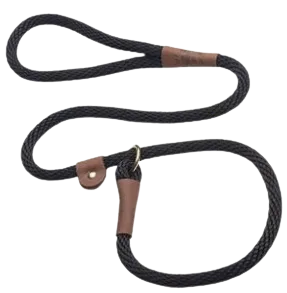
What role does positive reinforcement play in leash training, and how can I incorporate it effectively?
Positive reinforcement simply means you recognize and reward your dog for engaging in desired behaviors.
By rewarding your dog for these behaviors, such as walking politely on a leash or responding to cues, you reinforce those behaviors and strengthen the bond between you and your dog. To incorporate positive reinforcement effectively, use high-value rewards, such as treats or toys, to motivate your dog and provide immediate feedback when they exhibit the desired behavior. Consistency, patience, and positive reinforcement are essential for creating a positive learning experience for your dog during leash training.
Why does my dog pull on the leash?
Dogs often pull on the leash because they have a naturally faster gait than humans. Think about how you walk with a toddler - much slower than usual, right? In this case, we humans are the toddlers.
Your dog is eager to explore and usually pull because want to get to exciting things faster, like interesting scents or other animals. It's a natural behavior driven by their instincts and curiosity. Pulling on the leash and lunging on the leash should not be confused. One is driven by positive emotions, and the other is driven by negative emotions.

Contact Us:
In-Person Service Counties:
Essex, Morris, & Passaic counties
We are located in:
Parsippany-Troy Hills, NJ 07054
DISCLAIMER: Behavior modification is a collaborative process that depends on the consistent implementation of training techniques by the owner. While we specialize in fostering positive behavioral changes, no trainer can guarantee specific outcomes or "cure" a dog's behavior. As behavior is influenced by numerous factors, including environment and individual circumstances, the dog's behavior remains the responsibility of the owner.

© Copyright 2022. Born to Be Dog Training LLC.
All rights reserved.




